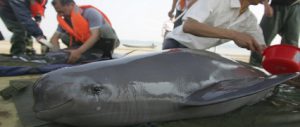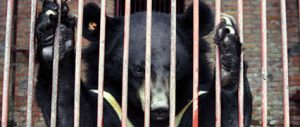Images of a dozen or more baby pandas being shown off to the public by researchers or reserve staff is a common sight in the media these days, giving the impression that giant-panda conservation is flourishing. This is misleading: captive breeding may have proved successful, but it’s no substitute for protecting wild populations and their habitats. Here, there is little cause for celebration.
There may be no qualitative biological difference between a panda raised in a warm enclosure and its cousin living wild in the mountains, but ecologically and aesthetically, the two are poles apart.
A useful phrase used by conservationists is “extinct in the wild”. The idea is that a species is only truly surviving when it has a population that can continue to live independently in its natural habitat.
After three decades of breeding and raising pandas in captivity, and thanks to significant technological advances, the population of captive pandas has jumped considerably and now sits somewhere between 300 and 400. But wild populations remain in crisis.
A national survey of panda populations and habitats is due to get under way soon. It is the fourth of its kind – the third survey, carried out almost 10 years ago, found 1,600 pandas surviving in the wild. The next round of research is keenly anticipated: just how successful has this last decade of conservation been?
A team of Peking University researchers studying the giant panda since 1984 has found that viable breeding populations still exist in the wild. Pandas do not face any major dietary problems – they are well adapted to feeding on bamboo – and the threat of poaching has been greatly reduced thanks to strengthened legal protections. The remaining obstacle to recovery of wild-panda populations is the destruction and break-up of their habitats. Conservation and restoration of those wild forest ecosystems is the key to panda protection. In fact, habitat conservation is crucial for all of China’s endangered species.
Since the 1980s, the government has done a great deal to bolster panda-conservation efforts. Sixty panda reserves are now in operation, and ample funding is provided by Chinese and foreign governments and NGOs. The giant panda has become one of the world’s most watched species.
Laws and regulations on wildlife protection and reserve management have meanwhile acted to reduce poaching. Since 1998, the government has halted logging on the middle and upper reaches of the Yangtze and invested heavily in projects to protect natural forests and return farmland to forest or grassland, providing an unprecedented opportunity for the restoration of panda habitats. Some habitats have indeed started to recover.
But I do not yet see cause for optimism. As part of efforts to develop the west of China, large transport and energy infrastructure projects are being built around, or even in, panda habitats, further dividing populations. Panda habitats are also being destroyed in the name of ecotourism. The outlook for recovery of wild panda populations remains bleak, and the key issue the protection of forest ecosystems.
Returning captive-bred animals to their natural habitats is one method of restoring wild populations of an endangered species. But there are no successful examples anywhere in the world of any kind of bear bred in captivity being successfully returned to the wild. Part of the reason is that bears tend to be “opportunistic” in their use of resources – as soon as they get used to a comfortable life alongside humans, they struggle to cope in the wild.
Preparing captive-bred bears for life in the wild is therefore hugely challenging. We cannot expect quick successes: we need long-term plans for both research and experimentation.
Panda experts have long agreed on the need for more research into the lifecycle and ecological context of the wild panda in order to guide efforts to return the animals to the wild. But little progress has been made.
In 2007, a captive-bred male panda named Xiang Xiang was returned to the wild by Wulong Panda Research Centre, but did not survive – he is thought to have fallen from a tree after being chased by other pandas. Subsequent research indicates new female arrivals are more readily accepted by wild populations than males. If that had been known earlier, the experiment may have been more successful.
The research centre has since been more cautious about returning pandas to the wild. A panda called Caocao and her cub are gradually being moved from a low-altitude training ground to higher-altitude locations. In April last year, the centre told the media that efforts to train pandas to be returned to the wild would expand.
These experiments have benefits for both scientific knowledge and the management of panda populations. But returning pandas to the wild does not solve the real thorn in the side of panda conservation. The main and urgent problem that wild panda populations face is the destruction and break-up of their habitat: if good habitats are available, the populations will grow naturally and there will be no need to introduce new individuals. Without high quality habitats, however, no matter how many pandas we raise in captivity, there will be nowhere to put them.
There is another worry. The successful artificial breeding and rearing of pandas at Wulong and at the Chengdu Panda Breeding Centre has become a model for others, and there are aspirations for more breeding centres and more baby pandas to demonstrate the successes of conservation. Such a proliferation of centres may lead to animals actually being taken from the wild to supply them – in fact, this is already happening. And it will have the same effect on wild populations as poaching.
The panda has unique cultural and diplomatic significance for China. Pandas have often been offered as gifts to other nations, or lent out for research or display in zoos. This was particularly important when work to conserve and breed pandas was just getting started: overseas cooperation helped advance China’s ability to breed and raise pandas and manage populations. Many Chinese scientists were trained during this process.
But, today, too much attention is paid to captive breeding programmes, and conservation in the wild has been demoted. This is a mistake.
Overall, China’s reserves are too poorly managed to provide for effective conservation of the giant panda. Most reserves have been split off from the forestry authorities, meaning the principles by which the reserves are run and the abilities of the staff require adjustment and improvement.
The experience of the last 20 years has taught us that conservation is not just about protecting a species – it is also about protecting the environment in which we live, the ecology that people and wildlife share and humanity’s spiritual homeland. How do you measure “success” in protecting a species? I say by the conservation and restoration of both the animal and its habitat.
Wang Dajun is a researcher at Peking University’s School of Life Sciences.
Translated by Roddy Flagg
Homepage image by robert wade



